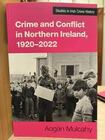
This book explores the dynamics between crime and conflict in Northern Ireland in the years since its foundation until the present. The starting point is the somewhat paradoxical situation whereby Northern Ireland has been historically ranked as a “low-crime” country, despite the fact that it is synonymous with a political conflict, which caused multiple deaths and injuries.
Aogán Mulcahy includes detail on the toll of conflict-related causalities from a range of sources documenting that more than 3,400 people died and approximately 48,000 people were injured in 1969-2022. This incredible burden is brought into sharper relief when it is considered alongside the relatively small size of Northern Ireland’s population (averaging 1.6 million over this time).
Since the foundation of Northern Ireland available data, including statistics on reported crime and crime and victim survey data, shows that so-called “ordinary crime” has remained comparatively low in Northern Ireland. How to explain this discrepancy?
One of the first issues to disentangle is how we define crime. Noting that a conflict-ridden society experienced less “ordinary crime” is cold comfort. But this book’s examination of the dynamics between crime and political conflict, and the extent to which the criminal justice system becomes intimately bound within this, is illuminating. Some of the definitional complexities involved in delineating between “ordinary” and “politically motivated” crime, and the sometimes blurred boundaries between the two are considered.
These are not just angels on the heads of pins debates. In the late 1970s the decision by the government of Margaret Thatcher to pursue a “criminalisation” strategy towards people involved in politically motivated offending, had immediate effects. The removal of their status as “political prisoners” led to the hunger strikes that resulted in the deaths of 10 men in 1981. Over this period the Royal Ulster Constabulary (RUC) became an increasingly militarised police force.
Some of the theories put forward for Northern Ireland’s “low-crime” status, during this time and the present day (although rates of crime have risen in recent years, they remain comparatively low), is that the political conflict acted to suppress other forms of criminal activities. In other words, people who may have been involved in offending had their energies diverted elsewhere. Another possible explanation is that high levels of social control, relatively high degrees of religiosity and close community cohesion meant that more commonplace offending such as thefts or burglary were relatively rare.
While acknowledging the potential validity of these explanations, Mulcahy is right to temper this analysis with a large pinch of salt. He notes, for instance, that in many societies specific types of crime are routinely underreported (domestic violence and sexual assault being two prominent examples), and in a context where the role of the police was highly contested, particularly among Catholic/nationalist/republican communities, the possibility of reporting crimes to the police becomes somewhat moot.
Further, the Historical Institutional Abuse Inquiry published in 2017, which investigated abuse in religious institutions in Northern Ireland towards children, in a similar vein to the Ryan report in the Republic of Ireland, provides multiple examples of offending against children that was not reported to authorities at the time. All of this lends weight to the view that crime statistics can only provide a partial picture of the extent of offending.
This book carefully considers these issues, while also providing insights into the way in which the function of the criminal justice system is bound to our ideas about the role and legitimacy of the state and its institutions. Considering three specific time frames in Northern Irish history – the period immediately after the foundation of Northern Ireland until the outbreak of the Troubles (1920-68); the political conflict (1969-1998) and the time since the Belfast Agreement (1999-2022) – Mulcahy explores these wider questions of state legitimacy.
The criminal justice system and its reform was part of the wider peace settlement. Most prominently the RUC was disbanded and the Police Service for Northern Ireland (PSNI) was established, and prisoners convicted of conflict-related offences were released as part of the Belfast Agreement. Northern Ireland is held up internationally as an example of a successful transition to peace. However, as this book notes, there is much unfinished business.
Paramilitary intimidation in communities remains a concern and there is differing perspectives on how the past should be addressed. This includes hundreds of cases where there has been no resolution for victims or families, both in the form of a proper investigation into atrocities or in terms of compensation.
The unsettled nature of the current political climate is underscored by the fact that the Northern Ireland Assembly has had a faltering existence in recent years and is in another period of suspension. Questions of justice and legitimacy are therefore ongoing concerns.
Nicola Carr is a professor of criminology at the University of Nottingham











